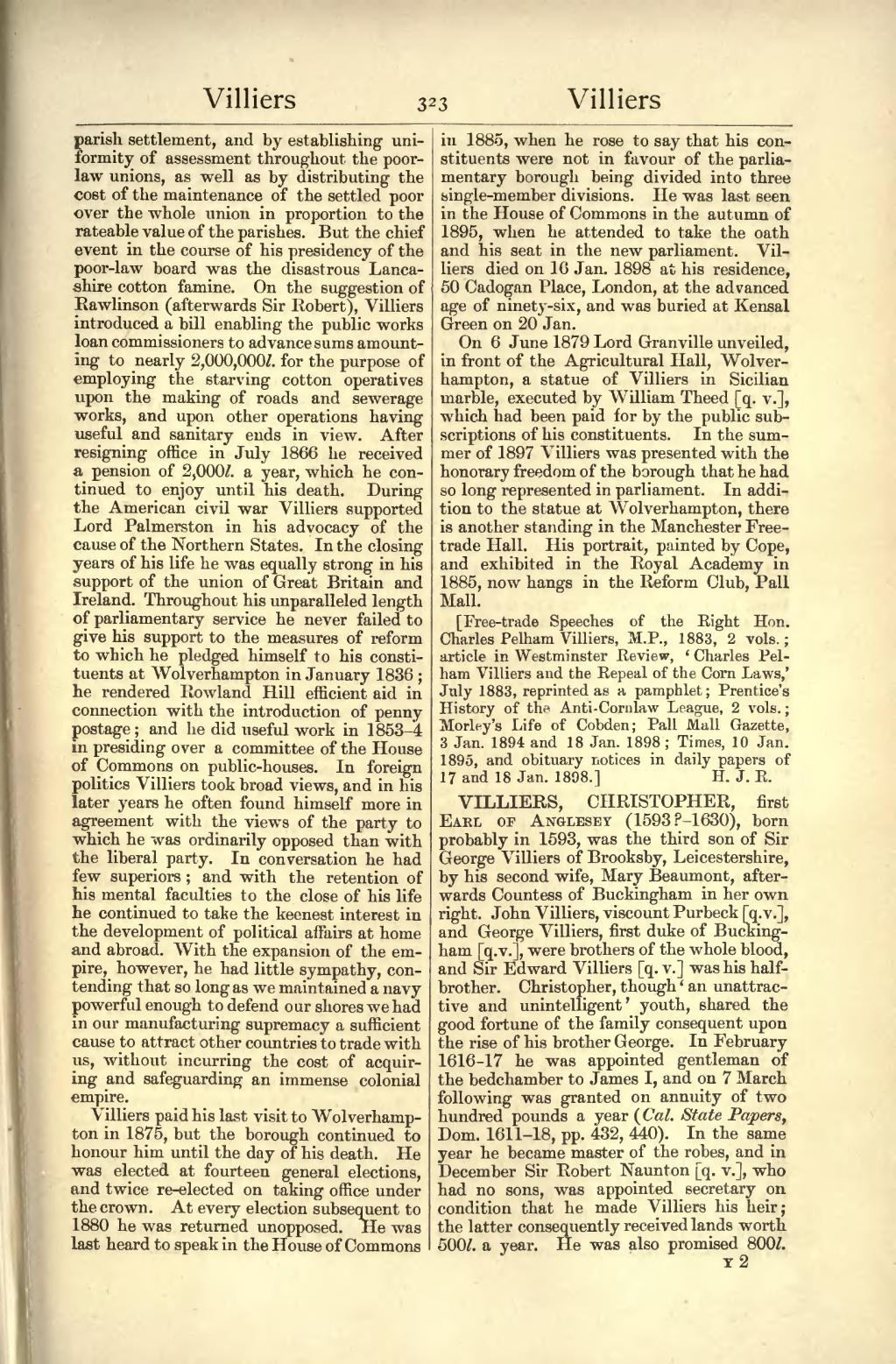parish settlement, and by establishing uniformity of assessment throughout the poor-law unions, as well as by distributing the cost of the maintenance of the settled poor over the whole union in proportion to the rateable value of the parishes. But the chief event in the course of his presidency of the poor-law board was the disastrous Lancashire cotton famine. On the suggestion of Rawlinson (afterwards Sir Robert), Villiers introduced a bill enabling the public works loan commissioners to advance sums amounting to nearly 2,000,000l. for the purpose of employing the starving cotton operatives upon the making of roads and sewerage works, and upon other operations having useful and sanitary ends in view. After resigning office in July 1866 he received a pension of 2,000l. a year, which he continued to enjoy until his death. During the American civil war Villiers supported Lord Palmerston in his advocacy of the cause of the Northern States. In the closing years of his life he was equally strong in his support of the union of Great Britain and Ireland. Throughout his unparalleled length of parliamentary service he never failed to give his support to the measures of reform to which he pledged himself to his constituents at Wolverhampton in January 1836; he rendered Rowland Hill efficient aid in connection with the introduction of penny postage; and he did useful work in 1853–4 in presiding over a committee of the House of Commons on public-houses. In foreign politics Villiers took broad views, and in his later years he often found himself more in agreement with the views of the party to which he was ordinarily opposed than with the liberal party. In conversation he had few superiors; and with the retention of his mental faculties to the close of his life he continued to take the keenest interest in the development of political affairs at home and abroad. With the expansion of the empire, however, he had little sympathy, contending that so long as we maintained a navy powerful enough to defend our shores we had in our manufacturing supremacy a sufficient cause to attract other countries to trade with us, without incurring the cost of acquiring and safeguarding an immense colonial empire.
Villiers paid his last visit to Wolverhampton in 1875, but the borough continued to honour him until the day of his death. He was elected at fourteen general elections, and twice re-elected on taking office under the crown. At every election subsequent to 1880 he was returned unopposed. He was last heard to speak in the House of Commons in 1885, when he rose to say that his constituents were not in favour of the parliamentary borough being divided into three single-member divisions. He was last seen in the House of Commons in the autumn of 1895, when he attended to take the oath and his seat in the new parliament. Villiers died on 16 Jan. 1898 at his residence, 50 Cadogan Place, London, at the advanced age of ninety-six, and was buried at Kensal Green on 20 Jan.
On 6 June 1879 Lord Granville unveiled, in front of the Agricultural Hall, Wolverhampton, a statue of Villiers in Sicilian marble, executed by William Theed [q. v.], which had been paid for by the public subscriptions of his constituents. In the summer of 1897 Villiers was presented with the honorary freedom of the borough that he had so long represented in parliament. In addition to the statue at Wolverhampton, there is another standing in the Manchester Free-trade Hall. His portrait, painted by Cope, and exhibited in the Royal Academy in 1885, now hangs in the Reform Club, Pall Mall.
[Free-trade Speeches of the Right Hon. Charles Pelham Villiers, M.P., 1883, 2 vols.; article in Westminster Review, ‘Charles Pelham Villiers and the Repeal of the Corn Laws,’ July 1883, reprinted as a pamphlet; Prentice's History of the Anti-Cornlaw League, 2 vols.; Morley's Life of Cobden; Pall Mall Gazette, 3 Jan. 1894 and 18 Jan. 1898; Times, 10 Jan. 1895, and obituary notices in daily papers of 17 and 18 Jan. 1898.]
VILLIERS, CHRISTOPHER, first Earl of Anglesey (1593?–1630), born probably in 1593, was the third son of Sir George Villiers of Brooksby, Leicestershire, by his second wife, Mary Beaumont, afterwards Countess of Buckingham in her own right. John Villiers, viscount Purbeck [q. v.], and George Villiers, first duke of Buckingham [q. v.], were brothers of the whole blood, and Sir Edward Villiers [q. v.] was his half-brother. Christopher, though ‘an unattractive and unintelligent’ youth, shared the good fortune of the family consequent upon the rise of his brother George. In February 1616–17 he was appointed gentleman of the bedchamber to James I, and on 7 March following was granted an annuity of two hundred pounds a year (Cal. State Papers, Dom. 1611–18, pp. 432, 440). In the same year he became master of the robes, and in December Sir Robert Naunton [q. v.], who had no sons, was appointed secretary on condition that he made Villiers his heir; the latter consequently received lands worth 500l. a year. He was also promised 800l.
